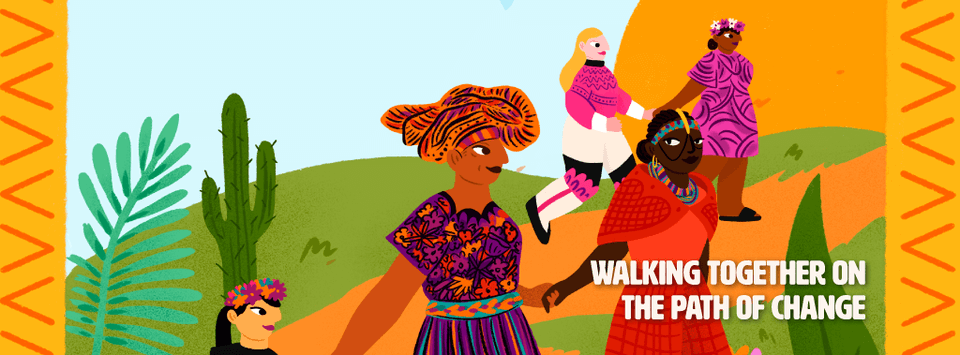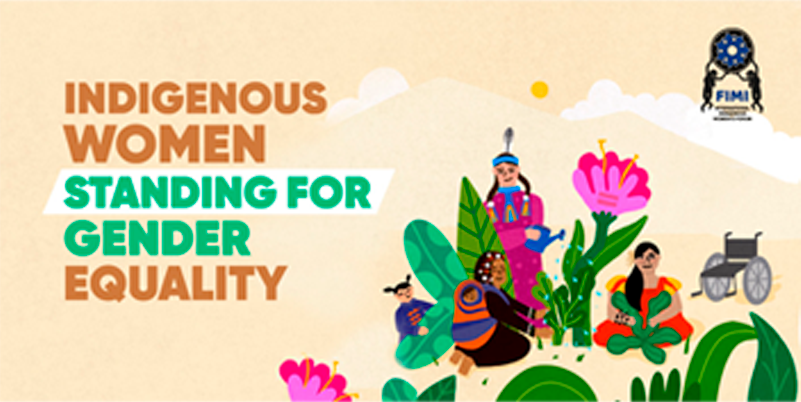Several Indigenous Women leaders have participated in various events of the Generation Equality Forum, held virtually from March 29 to 31, 2021. Indigenous Women of the world have been able to raise their voices, demands and strategies by participating at this global meeting intended to define the transformative actions that will be taken over the next five years to achieve gender equality.
Through the virtual events, participants have discussed the role of Indigenous Women in the face of climate change, the impact of COVID-19, the various types of violence and inequalities that we still face as Indigenous Women and Girls, and the direction the feminist movement should be taking.
“Nobody wants a feminist movement made up only of academics and the upper class. Feminism is rooted in diversity, in dialogue,” claimed Tarcila Rivera Zea, Quechua activist and chair of the Board of Directors of the International Indigenous Women’s Forum (FIMI-IIWF). This event has been a great opportunity for the particular contributions of Indigenous Women to be included in the global agenda towards gender equality.
The Need for an Intersectional and Decolonial Perspective in the Feminist Movement
Throughout the event, intersectionality has been the word uniting the voices of Indigenous Women. “The challenge is to make sure that, beyond the good intentions, intersectionality actually be put in practice once the Forum is done,” stressed Myrna Cunningham, co-founder and vice president of the Indigenous Initiative for Peace. “The colonial model keeps gaining strength around the world, and if we are not serious about applying intersectionality, everything will be ever more homogeneous,” she added.
Throughout their years of struggle, Indigenous Women have been gaining important rights, especially in normative law through the adoption of international and national legal instruments that pressure States into adopting specific policies.
However, as highlighted by Norma Don Juan Pérez of the National Coordination of Indigenous Women of Mexico (CONAMI), “all progress made is overshadowed by racist, non-intersectional policies”, which continue to fuel the different types of violence against Indigenous Women. “That is why we need to transform the way power is exercised,” stated Norma Don Juan. “Our ability to solve problems has to be recognized, and we have to be considered as subjects of law, able to define how we want to exercise our rights.”
Tarcila Rivera Zea has provided some practical solutions to include intersectionality and face the specific challenges of Indigenous Women. One of them is to push forward the general recommendation of the CEDAW Committee on the Rights of Indigenous Women and Girls.
It is also important to promote economic opportunities, and for Indigenous Women’s organizations to receive funding more directly. This requires believing in their ability to manage resources, as pointed out by Monica Aleman, senior coordinator of the Ford Foundation’s BUILD Program. Finally, it is important to build agendas that reaffirm this intersectionality, so as not to leave out any sector of society.
Indigenous Women Are the Best Guardians for Mother Earth
There is a certain consensus around the fact that Indigenous Women are those most affected by climate change. Crop failure caused by floods and extreme droughts undermines the progress made with the issue of food security. “Climate change is a nightmare in my country,” acknowledged Hindou Oumarou Ibrahim, co-founder and president of the Association of Indigenous Women and Peoples of Chad.
But at the same time, Indigenous Women are in a position to bring solutions. In the community, “they are the agents of change, they have a deep knowledge of the climate and of their environment, and they can offer environmental solutions. They should be included at the negotiation tables for the national plans,” added Hindou Oumarou Ibrahim. With the COVID-19 crisis, for example, the value of healing practices, spirituality and traditional medicine has been reaffirmed.
Additionally, Indigenous Women as guardians and defenders of Mother Earth have long been insisting on “the concept of ecological and environmental violence”, which has “challenged and expanded the established definition of violence,” explained Nicaraguan Indigenous Leader Myrna Cunningham.
For the challenges posed by both climate change and COVID-19, Lucy Mulenkei, Vice President of FIMI, has a recommendation: “Don’t work alone. We need to work with boys and girls, youth, families and communities.”
Violence and Inequalities Persist Against Indigenous Women and Girls
Although great progress has been made with regards to specific regulations and legislation, leading to the creation of government policies and programs to prevent violence, there is still work to be done for these words and intentions to actually become reality. Black, disabled and/or Indigenous Women continue to be the ones with the highest mortality criminalization rates. “The problem is the structural and economic inequality from which the violence stems,” explained Elvira Constantina Pablo Antonio, from the National Network of Indigenous Women of Mexico.
For Adriana Uex, young Indigenous Woman and a member of the National Coordination of Indigenous Women CONAMI, “racism and discrimination are the barriers” that are raised with these inequalities, which are in turn translated into a poor access to public health systems, the denial of our rights to make decisions about our own bodies, or child marriages.
Another type of violence affecting Indigenous Women very acutely is the appropriation of indigenous territories by transnational corporations, a situation that is aggravated by state-sponsored violence and impunity. “We need to provide global answers” from an “intercultural and feminist” perspective, recommended Norma Don Juan Pérez, from CONAMI.
According to Sandra Creamer, Executive Director of the National Aboriginal and Torres Strait Islander Women’s Alliance and a member of FIMI’s Board of Directors, corporations and states must be held accountable. “We have to establish international standards and focus our efforts around Human Rights conventions and guides,” she said.
With the COVID-19 pandemic, these inequalities have worsened. The ultra-rich have made huge profits while the wealth gap has widened. “Many Indigenous Women have had to migrate from rural areas to the city, where they do not have access to services,” explained Teresa Zapeta, Executive Director of FIMI.
This leaves us with “a complicated context, where we see progress at the same time as intensifying violence”, concluded Norma Don Juan Pérez. This is why Indigenous Women are making a call to action. In the words of Elvira Pablo, from the Youth Generation Equality Working Group: “We are tired of hearing pretty words and commitments without seeing immediate action. Now is the time to start acting.”




